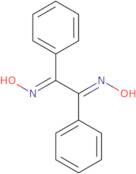Diphenylglyoxime
CAS: 23873-81-6
Ref. 3D-FD32386
| 10g | Discontinued | ||
| 25g | Discontinued | ||
| 50g | Discontinued | ||
| 100g | Discontinued | ||
| 250g | Discontinued |
Product Information
- (1E,2E)-N,N'-dihydroxy-1,2-diphenylethane-1,2-diimine
- (1Z,2E)-N,N'-dihydroxy-1,2-diphenylethane-1,2-diimine
- (E)-N-hydroxy-2-nitroso-1,2-diphenylethenamine
- (Z)-N-hydroxy-2-nitroso-1,2-diphenylethenamine
- 1,2-Ethanedione, 1,2-diphenyl-, 1,2-dioxime
- Ai3-18240
- Anti-diphenylglyoxime
- Benzil dioxime
- Benzil oxime
- Brn 2053615
- See more synonyms
- Dibenzoyl dioxime
- Diphenyl glyoxime
- Ethanedione, diphenyl-, dioxime
- Glyoxime, diphenyl-
- N-hydroxy-2-nitroso-1,2-diphenylethenamine
- Nsc 4042
- alpha-Benzyldioxime
- Diphenylethanedione dioxime
- 4-07-00-02505 (Beilstein Handbook Reference)
Diphenylglyoxime is a redox potential indicator that can be used to measure the activity of hydrogen peroxide. It has been used in gravimetric analysis, patterning, and as a substrate in electrochemical experiments. Diphenylglyoxime reacts with picolinic acid (PCA) to form a redox-active molecule that can be detected using nmr spectroscopy. The reaction mechanism of this process is not well understood, but it is believed that diphenylglyoxime first reacts with PCA to form a phenylhydroxypicolinic acid ester that undergoes an intramolecular cyclization reaction. This results in the formation of diphenylhydroxyquinone-2-carboxylic acid and diphenylglyoxylic acid. The hydroxyl group on the phenolic ring of diphenylglyoxylic acid reacts with the nitrogen atoms on PCA to form a five membered heterocycl





